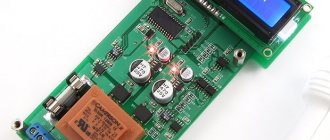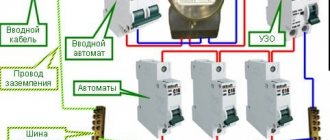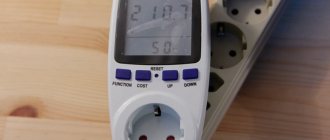| This article need additional quotes for verification . |
Wattmeter
V wattmeter
A tool for measuring electricity (or the rate of supply of electricity) in any given circuit. Electromagnetic wattmeters are used to measure network frequency and audio frequency power; other types are required for RF measurements.
The wattmeter reads the average value of the product v (t) i (t) = p (t)
where
v(t)
is the voltage with reference polarity in the ± terminal relative to the other terminal of the potential (pressure) coil, and
It)
is the current with reference direction flowing into the ± terminal of the current coil.
The wattmeter shows P = (1 / T) ∫0Т v (t) i (t) dt
, which in a sinusoidal steady state reduces to
V
rms value
i
rms value cos (φ), where
T
is the period
p (t)
φ is the angle , by which the current lags behind the voltage.[1]
Electrodynamic
An early wattmeter on display at the Historical Archives and Mining Museum in Pachuca, Mexico
A traditional analog wattmeter is an electrodynamic instrument. The device consists of a pair of fixed coils, known as current coils
, and a moving coil known as
a potential coil
.
The current coils are connected in series with the circuit, while the potential coil is connected in parallel. Also on analogue Wattmeters, there is an arrow on the potential coil that moves along the scale, showing the measurement result. Current flowing through a current coil produces an electromagnetic field around the coil. The strength of this field is proportional to the line current and is in phase with it. The potential coil, as a rule, has a large current. a resistor is connected in series with it to reduce the current flowing through it.
The result of this arrangement is that on a DC circuit, the needle deflection is proportional to both
then Current (
I
)
and
then Voltage (
V
), which corresponds to the equation
n
=
VI
.
For AC power, the current and voltage may be out of phase due to the delaying effects of the circuit's inductance or capacitance. The circuit deflection is proportional to the average instantaneous product of voltage and current, thus measuring the active power, p
=
VI
because
φ
.
Here cos φ
represents the force factor which indicates that the power transmitted can be less than the total power obtained by multiplying the readings of a voltmeter and an ammeter in the same circuit.
The two wattmeter circuits can be damaged by excessive current. The ammeter and voltmeter are both vulnerable to overheating - if overloaded, their readings will go off the charts - but in the wattmeter, one or even both of the current and potential circuits can overheat without
the pointer is approaching the end of the scale. This is because the position of the pointer depends on the force factor, Voltage and Current. Thus, a circuit with a low power factor will produce low wattmeter readings even when both circuits are loaded to their maximum safe limit. Therefore, the wattmeter is rated not only in watts, but also in volts and amperes.
A typical wattmeter in teaching laboratories has two voltage coils (pressure coils) and a current coil. Two pressure coils can be connected in series or in parallel to change the ranges of the wattmeter. A pressure coil can also be used to change the range of the meter. If the pressure coil has a 300 volt range, you can use half that range to make the range 150 volts.
Professional
These are more functional devices, they belong to stationary equipment, and are larger in size than their household counterparts. The error of a wattmeter for professional use is minimal; they operate within a wider range of current, voltage, and frequency.
Naturally, such devices are more expensive than their household counterparts; they are subject to higher requirements in terms of accuracy class, functionality, and other characteristics. They work with any current and can determine power with a wattmeter in single-phase and three-phase networks.
There are also panel wattmeters; they are built into single-phase or three-phase networks. They are highly accurate, the results are transmitted in the form of numbers to the display. The appearance of the device resembles a measuring head, which is mounted in the housing. Most often used in instrument panels.
Wattmeters are chosen depending on the area of application and purpose; there is no need to overpay for a functional device if you need to measure the power of a home refrigerator, but a household device is not suitable for professional use.
Electronic
Siemens electrodynamometer, circa 1910, F = fixed coil, D = moving coil, S = coil spring, T = torsion head, M = mercury cups, I = pointer Prodigit Model 2000MU (UK version) shown in action and showing that the device consumes 10 W.
Electronic wattmeters are used for direct measurements of low power or for power measurements at frequencies beyond the range of electrodynamometer type instruments.
Digital
A modern digital wattmeter measures voltage and current thousands of times per second. For each sample, the voltage is multiplied by the current at the same instant; the average over at least one cycle is the actual power. Real power divided by apparent volt-amperes (VA) is the power factor. The computer circuit uses the selected values to calculate RMS voltage, RMS current, VA, power (watts), power factor, and kilowatt-hours. Readings can be displayed on the device, stored for logging and average calculations, or transferred to other equipment for later use. Wattmeters vary significantly in how to correctly calculate power consumption, especially when the actual power is much lower than VA (very high reactive loads, such as electric motors). Simple meters can be calibrated to provide a specified accuracy for the sine waveform only. Waveforms for switching power supplies as used by many electronic equipment can be very far from sinusoidal, leading to unknown and possibly large errors at any power. This may not be stated in the meter manual.
Types of meters
Wattmeters are divided into mobile (wearable), stationary (panel), laboratory and household. All presented varieties can be made in analog and digital class of devices.
Mobile
This includes small-sized testers for one-time testing of load channels. Power for such devices is often obtained from the line being studied. There are options equipped with batteries or batteries. Network-dependent - often analogue, stand-alone - digital class.
Stationary
Connecting a stationary wattmeter is usually carried out in power panels of buildings, houses, apartments, or other points of central energy distribution. Laboratory devices are separate permanent measuring devices. The former are intended for the purposes of constant monitoring of line flow, the latter for a one-time, but highly accurate test of the electrical consumption of individual loads.
The stationary type wattmeter comes in analog and digital classes. The advantage of the first is unsurpassed reliability, the second is convenience and functionality. A common case of devices mounted in a panel and taking into account consumption can be called classic electricity consumption meters. Unfortunately, they do not determine “instant” values, but give an idea of the total cost of loading the line in kilowatt hours.
Household
Devices of this type are not very accurate and are usually designed to measure the flow of one, or less often two, household devices. The classic design is an adapter with an indicator, placed between the 220 V socket and the consumer plug. Such a wattmeter, plugged into a socket, can, depending on the model, show “instantaneous” total consumption, or divide it into active, reactive, complex and total kilowatt-hours.
Precision and accuracy
There are limitations to measuring power with inexpensive wattmeters or even with any meters not designed for low power measurements. This particularly affects low power consumption (eg less than 10W) used in standby mode; the readings may be so inaccurate as to be useless (although they confirm that standby power is low, not high).[4] The complexity is largely due to the difficulty of accurately measuring AC current rather than voltage, and the relatively small need for low power measurements. The meter specification must indicate the reading error for various situations. For a typical plug-in meter, the power error is specified as ±5% of the measured value ±10 W (for example, a measured value of 100 W may be off by 5% of 100 W plus 10 W, i.e. ±15 W, or 85–115 W); the error in kWh is ±5% of the measured value ±0.1 kWh.[5] If a laptop draws 5 watts in sleep mode, the meter may read anything from 0 to 15.25 watts, excluding errors due to non-sine waveforms. In practice, accuracy can be improved by connecting a fixed load such as an incandescent lamp, adding the device to standby mode, and exploiting the difference in power consumption.[4] This takes the measurement out of the low power problem area.
Household devices
This type of device usually refers to digital devices; they are produced in the form of a network adapter. Needed to measure the power of the device used or to determine the cost of electricity, if it is possible to independently set the cost of a kilowatt-hour. The principle of their operation is quite simple: a wattmeter is inserted into a socket, and in turn, the device under study is plugged into the wattmeter socket.
It will be interesting➡ Useful power
When you press the corresponding button, the countdown of the amount of energy consumed begins and its cost is immediately determined. If you need to determine the amount of power consumed, you simply switch the button, you can also determine current, voltage, or any other parameter, their number depends on the functionality of the model.
The measurement limit of this type of wattmeter usually does not exceed 4 kW. That is, by connecting almost any household appliance, you can easily determine the monetary costs that you will have to pay for its operation, for example, for a month.
Radio frequency
Devices with moving coils can be calibrated for direct current or mains frequency currents up to several hundred hertz. At radio frequencies, a common method is a rectifier circuit designed to respond to the current in the transmission line; the system is calibrated for a known circuit impedance. Diode detectors are either directly connected to the source or used with a sampling system that sends only a portion of the RF power through the detector. Thermistors and thermocouples are used to measure the heat generated by RF power and can be calibrated either directly or by comparison to a known reference power supply.[6] A bolometer power sensor converts incident radio frequency energy into heat. The sensing element is maintained at a constant temperature by a small direct current. The decrease in current required to maintain temperature is due to the drop in RF power. Instruments of this type are used across the entire radio frequency spectrum and can even measure visible light power. For high power measurements, the calorimeter directly measures the heat generated by the RF power.[6]
Best models
There are a large number of such measuring instruments on the market from European and domestic manufacturers. Each of them has its own advantages and disadvantages. It is necessary to study the most popular models in detail.
ROBITON PM-1
A device that helps control the consumption of electrical energy from the electrical network by 1 consumer. It combines in one housing a plug, a socket, an electrical unit and a monitor that reads the received data.
Makes it possible to calculate the power of a single load connected through the device. The wattmeter determines the amount of energy used over a specific time period and calculates the price of the electricity used.
- compact size, simplicity, reasonable price;
- ability to work with any household devices;
- the ability to determine the amount of energy that is consumed by the heater.
- zeroing is poorly thought out;
- only works in warm conditions.
HiDANCE 3680W AC Power Meter
Compact household electronic device with advanced functionality. Makes it possible to determine the strength of alternating current voltage. Power consumption and its coefficient are calculated.
There is a function for determining the price of energy used. The device is convenient when testing household appliances, electrical appliances and heaters of any type in order to calculate economic efficiency.
- bright design, neat assembly of the digital device;
- high-precision measurements, the result is clearly displayed;
- a large number of modes.
- it is necessary to enter the cost again after resetting the information;
- welded fork pins.
Espada TSL 1500WB
An easy-to-learn and use wattmeter that tests household appliances based on the level of energy consumed. Extremely convenient for checking electricity consumption when choosing a heater. The device shows the real power, expenses and price of electricity in the shortest period of time.
Helps calculate thermal efficiency and costs throughout the heating season. There is an option to enter information for a 2-tariff meter. The product signals an emergency situation or excess current or power.
- high-precision product, measurement speed;
- the monitor is illuminated, large numbers;
- electricity price calculation.
- inconsistent backlight;
- Difficult to change power source.
TP-Link HS110
The device controls and takes measurements at a distance via a network using a smartphone or other electrical device. There is an option to automatically connect or turn off energy consumers.
Monitoring over a distance of electricity consumption makes it possible to select the appropriate mode of operation of household appliances or heating systems. A wattmeter helps set the required power.
- remote control option;
- compact size, works with any household appliance;
- adequate cost.
- sensitivity to network quality.
Edimax SP 2101W
Smart device with power metering option. Connects to any standard network. The device will control the level of energy consumption, connect or disconnect household appliances independently, by command or according to a schedule.
Controls the functioning of household devices, automatically turning off the power in abnormal mode. Auxiliary function - an alarm signal is transmitted in automatic mode.
- “smart” socket that controls power;
- assistance in developing an economy regime;
- the result lasts throughout the year.
A wattmeter is a device that is needed in various fields, including in everyday life. Digital devices provide much more information. When choosing a product, you should take into account its technical parameters, operating frequency and development company. It must be remembered that modifications from China are much cheaper, but the quality and accuracy of their measurements are not at the highest level.
Wattmeters
Main article: Electric meter
Itron OpenWay Wattmeter with two-way communication for remote reading, used by DTE Energy
A watt-hour meter is essentially a wattmeter that integrates power over time (essentially multiplies power by elapsed time). Digital electronic instruments measure many parameters and can be used where a wattmeter is required: volts, current in amperes, apparent instantaneous power, actual power, power factor, energy in [k]Wh over a period of time and the cost of electricity consumed.
Varieties
The main criterion is the type of current - constant or alternating. Universal household appliances allow you to work with any consumer.
You need to insert the wattmeter into the socket, and into the device itself - the equipment whose parameters you want to set. Wattmeters are used when testing and repairing an electrical network or to calculate which device is taking too much energy.
How measuring devices differ from each other:
- accuracy - most devices are quite accurate, but information about the class (percentage of error) can be found in the product passport;
- measurement ranges – what power consumers are the measuring devices designed for. Simple cotton washing machine or large machine;
- additional functions - screen backlight, remote control and programming capabilities, built-in memory.
If you need to take measurements outdoors, you should find out at what air temperature the wattmeter is allowed to operate.
Why is it necessary in everyday life?
You will need to use a wattmeter to optimize energy costs. This is especially important for large apartments and country houses. A large number of consumers will not allow you to accurately determine which of them are too gluttonous and require replacement.
Smart wattmeters with additional functions will allow you not only to take measurements, but also to control a specific device. For example, an electric boiler. This can be done remotely or by programming the measuring device.
Expert opinion Pavel Maksimovich Torsunov For a more complete diagnosis, it is necessary to take measurements over a long period of time - at least several hours, since a number of consumers “take” different amounts of energy at different times.
Recommendations
- Close, Charles M. "Chapter 8: Force and Energy." Linear Circuit Analysis
. item 395. - Electricity meter
- US3959724A – Electronic wattmeter
- ^ a b
Lawrence Livermore Laboratory USA, Reserve Power, Measurement Reserve - The data is given in the text of the instructions for the inexpensive removable electricity meter Brennenstuhl PM230. The lowest measurable current is 0.02 A, which corresponds to approximately 5 W at 230 VAC.
- ^ a b
Joseph J. Carr,
RF Components and Circuits
, News, 2002 ISBN 978-0-7506-4844-8 pages 351-370
Technical specifications
In accordance with the specified technical parameters, the device is extremely useful for home use and makes it possible to evaluate the voltage in the electrical network, current, load power and electricity consumption.
- operating and test voltage: 80
260VAC;
- measured current: 0-20A;
- operating frequency (in the mains): 50-60 Hz;
- measured power: 0-4500W;
- electricity consumption: 0-9999 kWh (displays how much electricity is consumed by an electronic device connected to such a device in 60 minutes);
- operating ambient temperature indicators: 0-50 degrees;
- the indicated dimensions of 8.5 by 5 by 2.5 cm will correspond to real parameters.
Important! In addition to power, such a device is capable of measuring voltage, electric current, and frequency. Other capabilities of wattmeters will depend on the manufacturing company.










